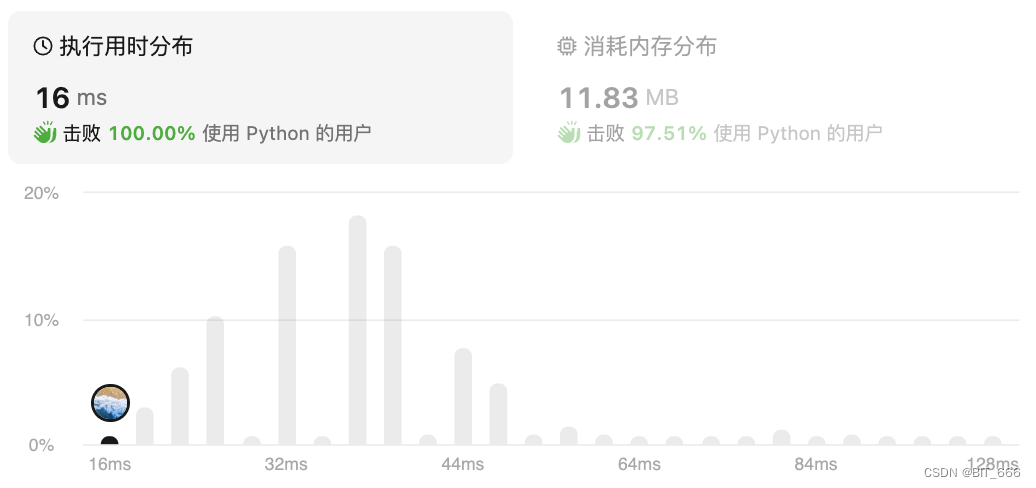本文主要是介绍Python - 深夜数据结构与算法之 高级字符串,希望对大家解决编程问题提供一定的参考价值,需要的开发者们随着小编来一起学习吧!

目录
一.引言
二.经典算法实战
1.Longest-Common-Sub-Seq [1143]
2.Edit-Distance [72]
3.Longest-Palindromic-Str [5]
4.Distinct-Sub-Seq [115]
5.Regular-Exp-Match [10]
三.总结
一.引言
上一节介绍了字符串的基本操作,本文介绍字符串更复杂的一些操作,主要设计动态规划与字符串扩展。
二.经典算法实战
1.Longest-Common-Sub-Seq [1143]
最长公共子序列: https://leetcode.cn/problems/longest-common-subsequence/description/

◆ 题目分析

状态转移方程:

根据二维 DP Table 理解转移方程更轻松些。
◆ 动态规划
class Solution(object):def longestCommonSubsequence(self, text1, text2):""":type text1: str:type text2: str:rtype: int"""m, n = len(text1), len(text2)dp = [[0] * (n + 1) for _ in range(m + 1)]for i in range(1, m + 1):c1 = text1[i - 1]for j in range(1, n + 1):c2 = text2[j - 1]if c1 == c2:dp[i][j] = dp[i-1][j-1] + 1else:dp[i][j] = max(dp[i-1][j], dp[i][j-1])return dp[-1][-1]

2.Edit-Distance [72]
编辑距离: https://leetcode.cn/problems/edit-distance/

◆ 题目分析

和上一题的 DP Table 类似,但是初始的边界条件有所不同,其次需要注意转换时需要计算三个位置的最小值。
◆ 动态规划
class Solution(object):def minDistance(self, word1, word2):""":type word1: str:type word2: str:rtype: int"""# w[i] = w[j] -> w[i][j] = w[i-1]w[j-1]# w[i] != w[j] -> w[i][j] = min(w[i-1][j-1] + 1, w[i-1][j] + 1, w[i][j-1] +1)M, N = len(word1), len(word2)# 状态空间dp = [[0] * (N + 1) for _ in range(M + 1)]# word1="" word2="xxxx" 则 word1 -> word2 需要变换4次, 同理可得另一种情况for i in range(M + 1):dp[i][0] = ifor j in range(N + 1):dp[0][j] = jfor i in range(1, M + 1):c1 = word1[i-1]for j in range(1, N + 1):c2 = word2[j-1]# 此时字符相等,该位置无需变换,所以二者相同if c1 == c2:dp[i][j] = dp[i - 1][j - 1]else:# 此时字符不同,需要看三种方法那种转换最小dp[i][j] = min(dp[i - 1][j], dp[i][j - 1], dp[i - 1][j - 1]) + 1return dp[-1][-1]
3.Longest-Palindromic-Str [5]
最长回文子串: https://leetcode.cn/problems/longest-palindromic-substring/description/

◆ 题目分析
首先明确回文串的定义,同时明确如果 i 或者 ii 为回文串时,我们可以向左右两边扩散,如果相同即为回文串。
◆ 中心扩散
class Solution(object):def longestPalindrome(self, s):""":type s: str:rtype: str"""# 中心扩散def palindrome(s, st, end):# 边界合法且左右相等则向两边扩散while st >= 0 and end < len(s) and s[st] == s[end]:st -= 1end += 1# 我们需要 st-end 最后多加减了一次实际是 st-1 end+1,所以需要回补return s[st+1: end]res = ""for i in range(len(s)):sub1 = palindrome(s, i, i)sub2 = palindrome(s, i, i + 1)if len(sub1) > len(res):res = sub1if len(sub2) > len(res):res = sub2return res
4.Distinct-Sub-Seq [115]
不同子序列: https://leetcode.cn/problems/distinct-subsequences

◆ 题目分析
- 确定 DP 定义:
dp[i][j]:以 i-1 为结尾的 s 子序列中出现以 j-1 为结尾的 t 的个数为 dp[i][j]。
- 确定递推公式:
s[i-1] == t[j-1] - 此时 dp[i][j] 可以不考虑这两个位置,所以复用 dp[i-1][j-1];当然也可以考虑 dp[i-1][j] 的情况,即 s[i-1] 结尾子序列中出现以 j 结尾的 t 的个数,因为我们计算的是 s 中有多少个 t,不是 t 中有多少个 s,

- 初始状态
dp[i][0] 表示:以 i-1为结尾的 s 可以随便删除元素,出现空字符串的个数,所以 dp[i][0] = 1
dp[0][j] 表示:空字符串 s 可以随便删除元素,出现以 j-1 为结尾的字符串 t 的个数,dp[0][j] = 0
dp[0][0]: dp[0][0] 应该是 1,空字符串 s,可以删除 0 个元素,变成空字符串 t。
◆ 动态规划
class Solution:def numDistinct(self, s, t):m, n = len(s), len(t)dp = [[0]*(n+1) for _ in range(m+1)]for i in range(m+1):dp[i][0] = 1for j in range(1, n+1):dp[0][j] = 0for i in range(1, m+1):for j in range(1, n+1):if s[i-1] == t[j-1]:dp[i][j] = dp[i - 1][j - 1] + dp[i - 1][j]else:dp[i][j] = dp[i - 1][j]return dp[-1][-1]
5.Regular-Exp-Match [10]
正则匹配: https://leetcode.cn/problems/regular-expression-matching/

◆ 题目分析
首先判断第一个字符是否相同:
- 此时要么 s[0] = p[0] 或者 s[0] 随意 且 p[0] = "."
如果第一个字符相同,则进行推进,分多种情况:
- 如果此时 p 长度大于 2 且第二位 为 "*",则进入 "x*" 的匹配逻辑:
- 不需要 x* 匹配,默认 x 为 0 位,则直接忽略 2 位 p -> s 不变,p 推进两位 p[:2]
- x* 匹配了一个,接着匹配 x,则 s 推进1为 s[1:],p 不动,因为还在匹配 x
- p 非 "x*" 的状态,则判断第一位是否匹配,匹配后 s、p 同步推进 [1:]
◆ 递归实现
class Solution(object):def isMatch(self, s, p):""":type s: str:type p: str:rtype: bool"""# 模式为空时 只能匹配空串if len(p) == 0:return len(s) == 0# s 第一个字符与 p第一个字符相等或者 p 第一个字符为 "."firstMatch = len(s) >= 1 and (s[0] == p[0] or p[0] == '.')if len(p) >= 2 and p[1] == '*':# 0 * Char 的忽略情况 与 消除一个前面的字符继续保留该通配符return self.isMatch(s, p[2:]) or (firstMatch and self.isMatch(s[1:], p))# 硬匹配后同步推进return firstMatch and self.isMatch(s[1:], p[1:])超时了,因为第二步 "x*" 会出现重复多次的情况。

◆ 递归 + Cache
class Solution(object):def __init__(self):self.cache = {}def isMatch(self, s, p):""":type s: str:type p: str:rtype: bool"""def DFS(i, j):if (i, j) in self.cache:return self.cache[(i, j)]# 模式为空时 只能匹配空串# if len(p) == 0:# return len(s) == 0if j == len(p):return i == len(s)# # s 第一个字符与 p第一个字符相等或者 p 第一个字符为 "."# firstMatch = len(s) >= 1 and (s[0] == p[0] or p[0] == '.')firstMatch = i < len(s) and (s[i] == p[j] or p[j] == ".")# if len(p) >= 2 and p[1] == '*':if j + 1 < len(p) and p[j+1] == "*":# 0 * Char 的忽略情况 与 消除一个前面的字符继续保留该通配符# self.isMatch(s, p[2:]) or (firstMatch and self.isMatch(s[1:], p))re = DFS(i, j+2) or (firstMatch and DFS(i+1, j))self.cache[(i, j)] = rereturn re# 硬匹配后同步推进# return firstMatch and self.isMatch(s[1:], p[1:])re = firstMatch and DFS(i+1, j+1)self.cache[(i, j)] = rereturn rereturn DFS(0, 0)把上面的代码转换为 DFS 并添加 cache,大家可以对照着之前的代码转换下。

三.总结
高级字符串的题目一般需要用到动态规划的方法,我们可以构建 DP Table,dp[i][j] 转移需要左上的三个位置的信息,根据题目的不同,做相应的取舍。
这篇关于Python - 深夜数据结构与算法之 高级字符串的文章就介绍到这儿,希望我们推荐的文章对编程师们有所帮助!




